Digital Media Consultant
Facebook Conversions API: Accelerate your server-side data collection
Digital Media Consultant
For a few years now, consumers have become increasingly aware that they generate data when they’re online. In fact, according to a recent survey, close to 97% of the population is concerned with protecting their personal data. For this reason, many big digital players have established measures that enable users to better control the data they share online. Changes such as Apple’s creation of the App Tracking Transparency framework or the removal of third-party cookies announced by Google will have major effects on companies whose marketing activities currently rely on the analysis and activation of data. It goes without saying that we’re about to experience the biggest shakeup in our industry in years.
In order to be able to adapt to this evolving context, Facebook strongly recommends that advertisers integrate its conversions API (Conversions API or CAPI for those already familiar with it).
What’s so great about Conversions API (CAPI)?
Formerly known as Facebook Server-Side, Conversions API’s main purpose is to send information that’s impossible to get with a pixel (such as in-store sales or calls) in order to bring performance reports and optimization to a whole new level.
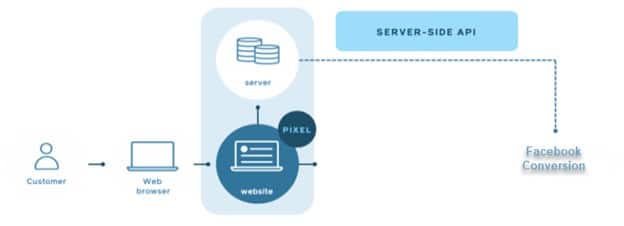
The basic pixel gathers information relating to activities on the site and sends them to Facebook through a third-party cookie. Just to remind you, a third-party cookie allows the sharing of information between two different domain names.
![]()
Given the coming disappearance of third-party cookies, CAPI will allow you to continue sending information to Facebook through server-side data transfer, thereby getting around client-side limitations.
The idea is to collect a maximum of primary data in order to increase the chances of matching them with a user. For example, the only primary cookie data limits the ability of the social media giant to recognize a user. On the other hand, if you configure your server integration by adding an IP address, an email address or external identifier, for example, Facebook can now adequately identify the user and use this data to ensure the proper functioning of its advertising activities.
![]()
In a recent webinar for its partners, Facebook predicted that the optimization of conversions with a web pixel would no longer be possible by the end of 2021. Advertisers that don’t migrate to CAPI will therefore be forced to optimize based on lower value actions, such as clicks. This type of optimization could prompt an average increase of 150% in your costs per acquisition. Trust us, you don’t want to go there! 😉
Other than avoiding the interruption of digital media activities, using Facebook’s conversions API enables advertisers to take advantage of many benefits, including:
- better visibility on conversions through the capacity to send additional information such as CRM data, in-store sales and qualified leads (MQL/SQL);
- better control of shared data given the possibility of adding quantitative and qualitative data such as product margins or customer lifetime value; and
- more robust integration, since CAPI is less likely to be affected by site crashes or lost connections, for example.
Maximize the volume of primary data sent
Primary (first-party) data form the core of CAPI’s operations. Generally speaking, CAPI needs at least one user attribute for transmission to Facebook. To explain it in a simplified way, when CAPI sends anonymized user data to Facebook, the social media giant tries to find at least one occurrence of this information in its internal database. When such an occurrence is found, FB can assign an action, since it recognizes this user within its member base. You must therefore gather as much information as possible on this user in order to maximize the matching potential with Facebook.
When we’re talking about user data, we’re referring to the following attributes:
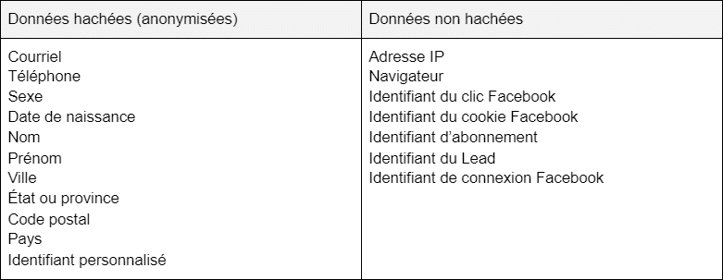
Application with purchase example
Now let’s put all this into practice! In the example below, we attempt to track a purchase without third-party cookies using CAPI. If we send information relating to the primary cookie, email address and personal identifier (external ID), the matching potential with a user is higher. Note that the primary cookie is set through a web pixel, which is why Facebook recommends using a pixel in tandem with CAPI. The duplication of the event will happen subsequently in the platform.
Facebook Example of information collected and sent using CAPI and the Facebook match:
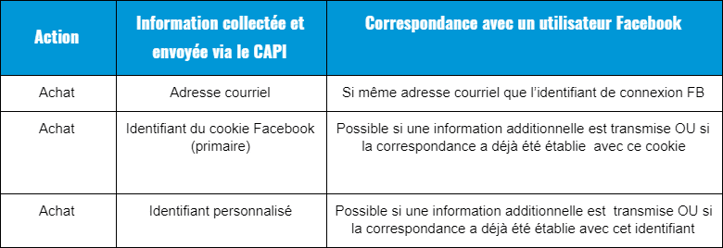
Let’s go more in-depth with a concrete example.
Example 1: Sending an anonymized email
A user lands on your website and wants to make a purchase. To do so, one of the conditions required is that the user enters their email address into a confirmation form. Since the purchase is considered a conversion, CAPI records it as such and sends a request to the Facebook server. The request contains the anonymized email address for the user (in accordance with all the rules surrounding user consent).
Once Facebook receives the data, it tries to find this email address amongst its billions of profiles in its database. If it succeeds, the conversion is attributed to the identified user.
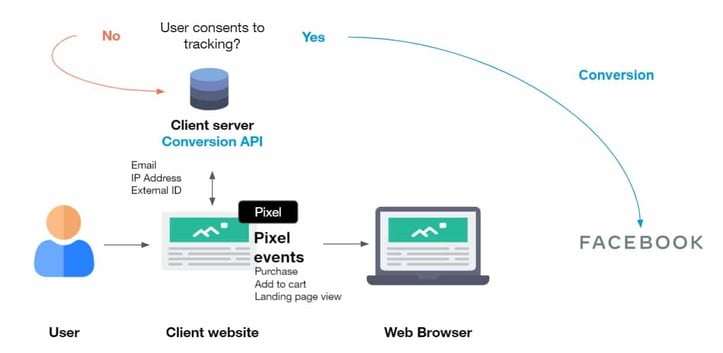
Example 2: Sending a primary cookie
When a Facebook pixel is installed on your site, it creates a primary cookie to identify visitors. This cookie is stored in an fbp variable under the domain name of your website. In general the content of this cookie takes the following form:
fb.1.1596403881668.1116446470
Why use a cookie with CAPI? This indicator is placed on every page of your site and can be sent as a result of every action. When additional information is sent on a user, such as their email address, Facebook can then recognize that the previous actions recorded by this primary cookie are attributable to the same user.
The information transmitted between your web server and Facebook resembles the text file below, with the fbp variable clearly identified in the “user data” section:
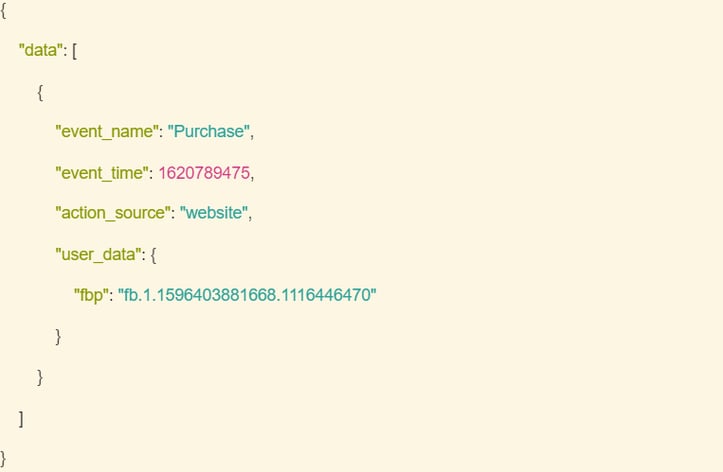
Example 3: Sending a personal identifier
Sometimes you need to send specific information that is related to your organization to an anonymized client number, the primary cookie for another platform or even a loyalty program identifier. Facebook gives you the option to indicate the desired type of attribute through a personalized variable called external ID. The recommendation is to send the information with other identifiers in order to more efficiently construct a profile of your users. For example, here is a message containing an anonymized external ID sent to Facebook by CAPI.
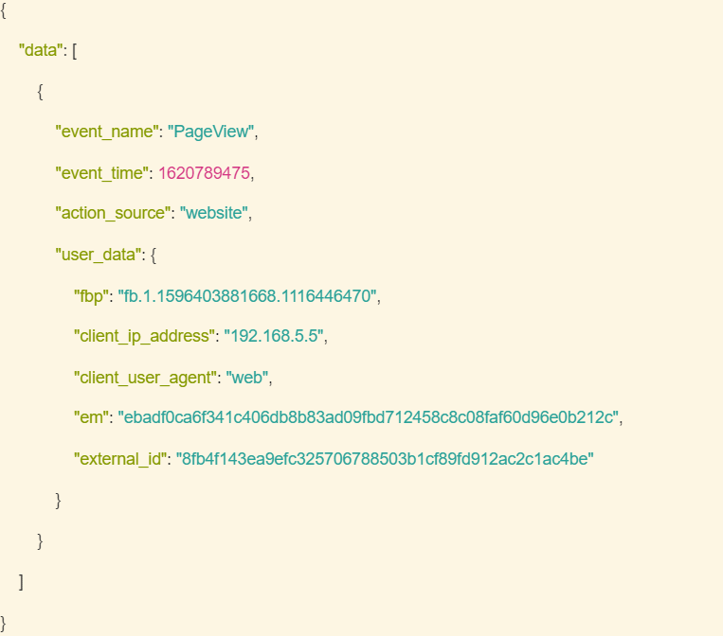
The limits of CAPI
While CAPI is an effective tool that we strongly recommend using, it’s not without its limitations, three of the main ones being:
- It’s a lot more complicated to integrate than the web pixel and requires particular skills if you want to add it to your platform without the help of a development partner.
- In many cases, CAPI comes with fees, as opposed to the web pixel. Its integration necessarily involves infrastructure costs since it’s set up on the server side (as its name indicates) and you have to pay to access a host server. If you go with Google’s App Engine, that will cost you around $50 per server on a monthly basis. If you follow the advice of the team at Google and get three in order to limit data losses in case of a server crash, the bill increases to around $150 a month. Otherwise, you could decide to go with services offered by an integration partner such as Zapier or Segment. WordPress also offers integrations with PixelYourSite.
- It’s a technological solution for an industry problem. It does NOT give you the authorization to ignore consumers’ desire to not be tracked if that’s their preference.
Procedure for integrating Conversions API (CAPI)
Now that you have a better understanding of how CAPI works, here’s what you need to get started:
- a Facebook pixel on your website (although it’s not a requirement, it will improve the quality of the events transmitted);
- a Facebook Business Manager account (something every company should have!); and
- an access token, which you can find through the FB event manager (recommended) or by using your own application.
Once the token is generated, the event manager will give you access to a new tab called “Implementation.” Click on this tab and follow the instructions on screen. Facebook will guide you through the steps for creating a CAPI application and a system user for the conversions API.
Ready, set… go!
Go to the event manager and select Add events using the conversions API.
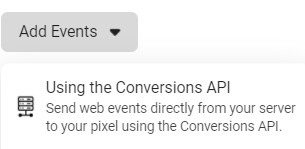
You will be asked to select the events you would like to track.
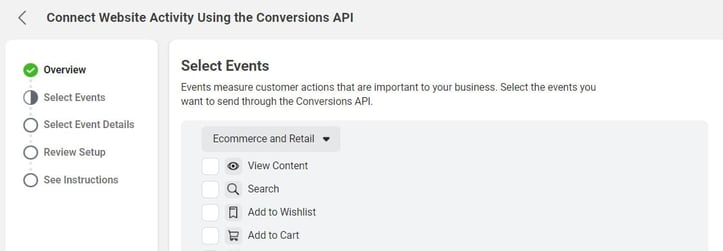
You must then choose the advanced parameters (custom parameters) you would like to send to Facebook as well as the information parameters about the customer. The more information parameters you can send, the greater the likelihood of a match with a user. Before forwarding them to a developer, ensure that all the events you want to send are actually available on your website. This goes without saying, since obviously you can’t send an email address if the customer isn’t providing one.
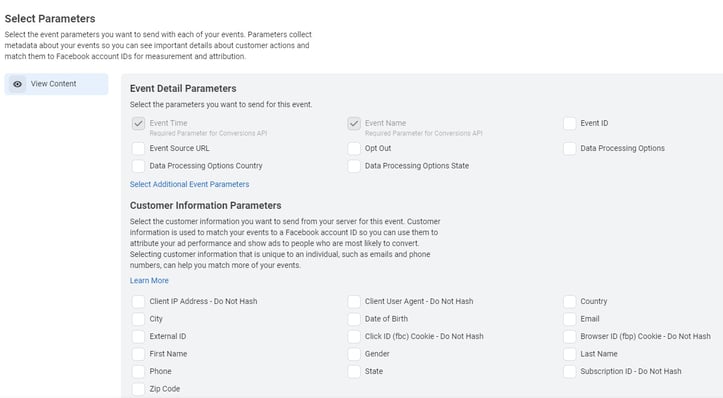

Once you have had your configuration reviewed, you will be asked if you want to do the integration yourself or if you need help from a developer. If you’ve already generated your access token, you can skip to the next section, which covers event configuration with a payload (data sent through the http web protocol).
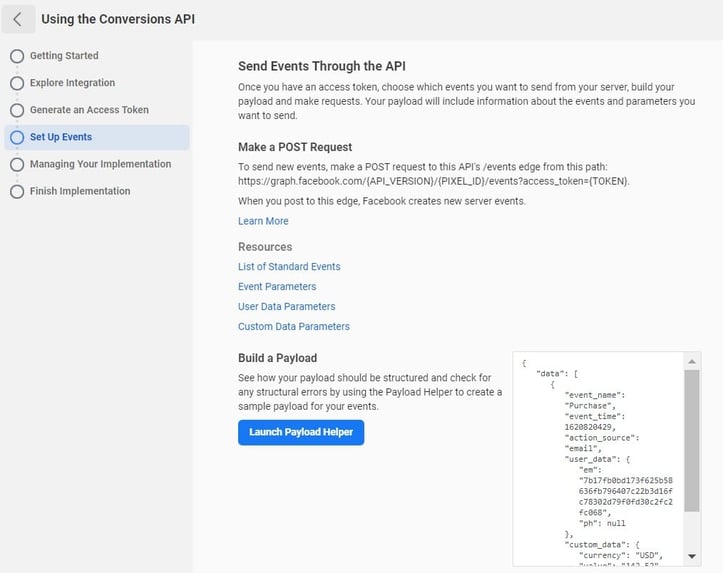
You can build your payload with all the information shared beforehand by a colleague (or with yourself!)
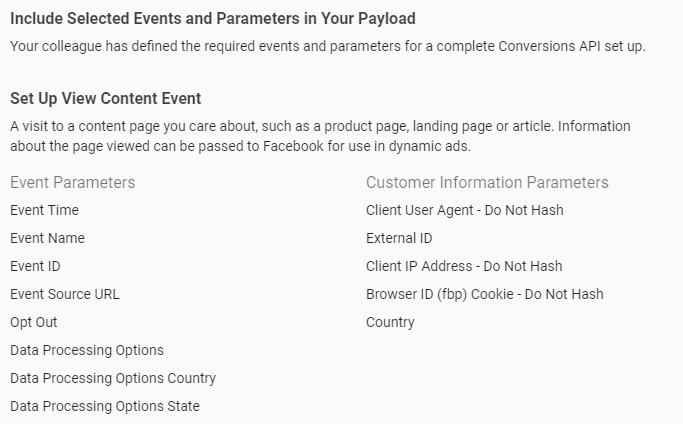
Once the payload is created, you need to host it server-side, which can be accomplished with Google Tag Manager (section Server-Side tagging), for example.
Note that the conversions API can be integrated directly on your server by a development team or even with the support of integration partners such as a tag manager (GTM Server-Side), a CDP (Segment, Tealium), an integration system (Zapier), etc.
In all of the above situations, the team at Adviso can guide you through the integration process for a next-generation tracking system.






